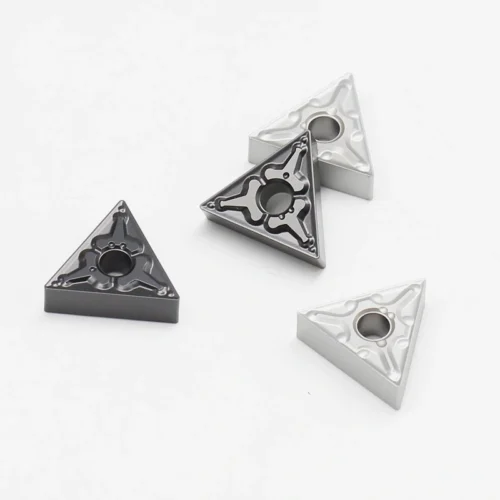Advantages of machining stainless steel turning insert TNMG1604
Stainless steel is a common and difficult material.
Due to its high toughness, high hardness and poor thermal conductivity, many people often encounter problems such as tool sticking, built-up edge and fast tool wear when machining stainless steel. So, how to turn stainless steel efficiently and worry-free?
The answer is simple: choose an insert optimized for Austenitic steel, such as TNMG1604-MA or TNMG1604-MS.
This insert has become the first choice for many customers due to its excellent chip evacuation performance, wear resistance and cost advantages.

What is TNMG1604?
Let’s first take a brief look at the meaning of the model:
T: Equilateral triangle blade, three corners
N: 0° back angle, high rigidity
M: Medium precision grade
G: Double-sided blade, with hole design
1604: side length 16mm, thickness 4.76mm, blade tip radius (0.4/0.8/1.2, etc. depending on the model)
If the suffix is MA/MS, it is a chip breaker specifically for stainless steel. It can not only easily deal with the problem of 316 steel sticking, but also maintain good cutting performance at higher speeds.
TNMG1604 Four advantages of stainless steel processing
1. Smooth chip breaking, say goodbye to tool sticking
The most troublesome problems in stainless steel processing are built-up edge and tool sticking. TNMG1604-MS/MA blades use chip breaker grooves designed specifically for 316 steel, which can effectively control the flow of chips
2. Wear-resistant and heat-resistant, longer tool life
We use a high-toughness carbide substrate combined with a nano-level PVD coating (such as TiAlN or TiCN) to keep the blade sharp at high temperatures
Effectively prevent chipping, wear and oxidation. When processing 304, 316, and 321 steel, the blade life is significantly longer.
3. Light cutting and low machine load
Thanks to the optimized design of the MA/MS chip breaker, the blade feeds lightly and has low cutting resistance, effectively reducing the machine tool load and energy consumption. Especially in continuous processing of CNC lathes, it performs particularly well.
Comparison between stainless steel TNMG and cast iron TNMG
Many customers will ask: “I used TNMG160404-HK to process cast iron before, can I use it to process 304 steel directly?”
The answer is: It is not recommended.
| Compare Projects | TNMG-HK(For cast iron) | TNMG-MS/MA(For stainless steel) |
| Material characteristics | High hardness, resistant to abrasive wear | High toughness, anti-adhesion wear |
| Coating Type | CVD(Thick Film) | PVD(Thin film, heat-resistant and anti-stick) |
| Chipbreaker design | Deep groove, suitable for chip breaking of brittle materials | Shallow bend, suitable for chip breaking of tough materials |
| Key Benefits | Wear-resistant, suitable for high-speed dry | Non-stick knife, good heat dissipation, impact resistance |
| Typical processing materials | Gray cast iron, ductile iron | 304、316、321、2205 Stainless steel |
| Whether to swap | ❌ Not recommended | ✅ More targeted |
Summary: TNMG for cast iron emphasizes wear resistance and is used to deal with brittle materials, while TNMG for stainless steel focuses more on anti-sticking, high temperature resistance and toughness.
